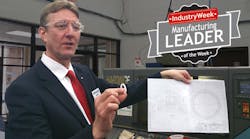RICHMOND HILL, Ontario, Canada — Like many prudent leaders, Iain McColl considers his thoughts, measures his words and shares plenty of information, but never too much. He is the kind of person you should listen to, not the kind who will shout for your attention.
McColl is the president and CEO of Hibar Systems, an engineering company that specializes in precision liquid dispensing, provides automation solutions to other manufacturers, and manufactures almost all of its own equipment. About 140 employees, most of them skilled engineers, work at its headquarters in a suburban business development just north of downtown Toronto.
“We’ve won a few recent awards,” McColl said during a tour of those headquarters, his excitement for the company, its products and its contributions to other manufacturers relatively reserved in tone. “Locally, we’ve won some business awards from the mayor. We were one of Canada’s best-managed companies the last two years. Probably the awards I’m most proud of are these” — a pair of plaques. “These are export awards.”
Hibar is a clearly Canadian company, from its leadership, to its modesty — VP Steve Mark said most sales are made thanks to relationships, and joked that “we’re not strong salesmen” — to it geographic location. It is, however, incredibly international in terms of where its products land. It is an exporter.
“Traditionally, more than 97% of what we make here is exported around the world,” McColl said. “The United States, Japan, Germany, with other European and Asian countries making up the rest of the pie.”
Hibar is statistically wise to focus on the global market and export its pumps and automation systems. In terms of overall productivity, Canadian manufacturers that export their goods outperform their non-exporting counterparts by more than 30%, with exit rates almost 70% lower, according to “The Future of Productivity: Smart Exporting for Canadian Companies”, a 2015 report from Deloitte.
“Exporting improves performance and lowers overall risk,” Peter E. Brown, senior practice partner at Deloitte and national co-leader of the Canada’s Best Managed Companies program, said in that report. “That seems like a disconnect, but companies that export are more diversified and more likely to invest in technology.
“There is a parallel to innovation, because you’re taking some of your profit and putting it back into the business, into new products or systems, which will help you stay ahead of your competitors. If you aren’t doing that, then you risk your competitors outpacing you.”
Perhaps not surprisingly, Hibar does invest to keep ahead of the pace, pouring about 10% of its annual revenues back into research and development.
So, how has a smaller Canadian company positioned itself to be an international player at a time when exports and imports are becoming a hot topic?
Domination of its industry niche helps. Few companies globally, if any at all, can match Hibar’s pumps’ precision, and the company services the full battery industry, with long partnerships with Duracell, Eveready, Panasonic and Rayovac, among other big names. “We focus on general industrial automation — which can be special-purpose machinery for virtually any application,” McColl said. “Packaging, pharmaceutical, cosmetics, food, technical industries.”
Its headquarters head count of 140 employees and status as an employee-owned company helps, too. “We have some special capabilities thanks to our size when it comes to innovation,” McColl said. “We’re not so large that we have a lot of corporate inertia to overcome obstacles, and our customers come to us because we have the ability to go from an idea to production relatively quickly. We have a very good team at rapid prototyping, concepting, proof of principle testing. We take ideas, we verify them, then we put them into practice.”
Vertical integration is key for Hibar, which was established in 1974 and has operated predominantly as an exporter ever since. “We have all of these disciplines under one roof that can take these ideas from our customers and walk them all the way through to a production-worthy piece of equipment at the end of the day,” McColl said. “We make the majority of parts for our machines in-house — you can hear them out there — and we make most of our components from our own engineering designs. Of course, we take those components and we manufacture them in-house, and that also includes electrical assembly, so we build our own control panels, we do our own field wiring.”
And, of course, location, location, location. “Ontario is a little bit of a heartland for automation and modern industrial companies,” McColl said. “There are companies we support and others who can support us. If we run out of capacity, which happens from time to time, we have a good local infrastructure of capable companies that can do machining for parts for us.”
Even with a recently struggling auto corridor, western Ontario has developed into a hotbed for manufacturing, from education and entrepreneurship, to established companies shipping their products out of Canada. The province was back in the headlines last week after General Electric officially broke ground on a new IIoT-connected engine factory in Welland, about 95 minutes directly south of Hibar’s headquarters.
“We have good shipping routes, too,” McColl said, “for our equipment to go worldwide.”



